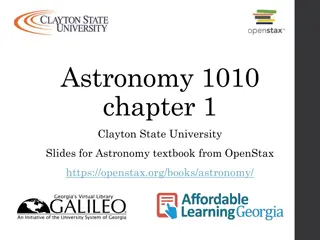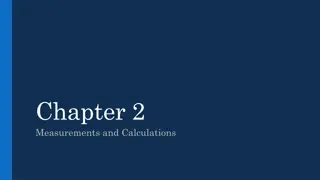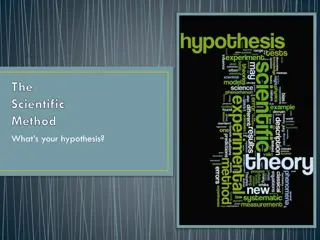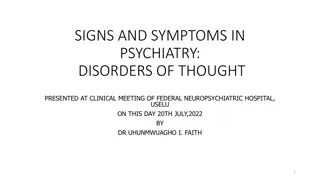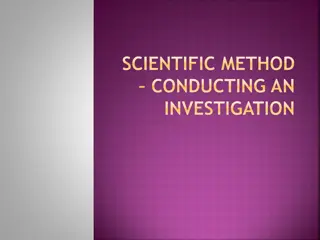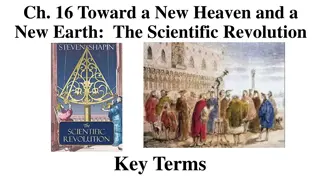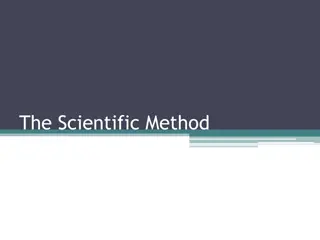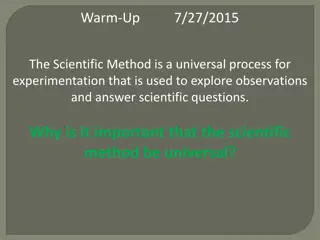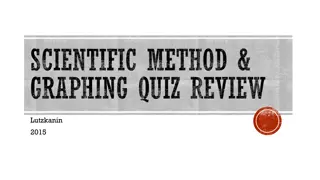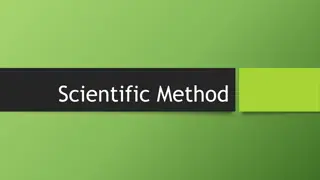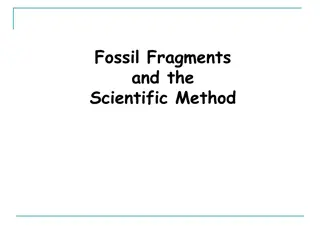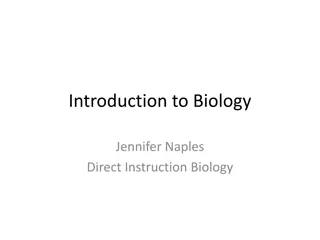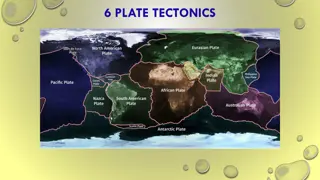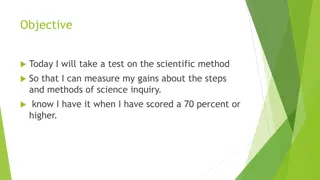Evolution of Scientific Thought and the Scientific Method
Explore the evolution of scientific theories and methodologies through the works of influential figures like Aristotle, Copernicus, Galileo Galilei, and Francis Bacon. From the geocentric beliefs of Aristotle to the heliocentric model proposed by Copernicus, witness the shift in paradigms and the emergence of the scientific method for gaining, organizing, and applying new knowledge. Learn about the key steps in the scientific method, from recognizing a problem to formulating general rules, and understand the importance of testability in scientific hypotheses.
Download Presentation

Please find below an Image/Link to download the presentation.
The content on the website is provided AS IS for your information and personal use only. It may not be sold, licensed, or shared on other websites without obtaining consent from the author. Download presentation by click this link. If you encounter any issues during the download, it is possible that the publisher has removed the file from their server.
E N D
Presentation Transcript
Aristotle-3rdCentury BC Philosopher (scientist); believed the Earth was the center of the universe Aristotelian-a believer in Aristotle s theory of the universe Copernicus-16thCentury Astronomer; believed the Sun was the center of the universe Copernican-A believer in Copernicus theory of the Universe Heretic-A person who does not believe in the established theory Inquisition-Trial of a person or group because of their beliefs or lack of
The Most Basic Science About the nature of basic things Motion, forces, energy, matter, heat, sound, light Ideas reach up to more complicated sciences Uses Mathematics to describe and analyze o o
Galileo Galilei (1564-1642) and Francis Bacon (1561-1626) usually credited as creating the scientific method a method that is effective in gaining, organizing, and applying new knowledge scientific method
1. Recognize a problem 2. Make an educated guess (hypothesis) the answer. 3. Predict the consequences of the hypothesis. 4. Perform Experiments to test prediction. 5. Formulate the simplest general rule that organizes the 3 main ingredients: hypothesis, prediction, experimental outcome. hypothesis) about
Fact observers of a series of observations of the same phenomena Law and over and finding no contradictions Theory information that attempts to explain a scientific idea. Fact-a close agreement by competent Law-the result of testing a hypothesis over Theory-a synthesis of a large body of
In order to be classified as scientific, a hypothesis must be testable. Must be a test for proving it wrong Example-Which is a scientific hypothesis? 1. 2. the existence of which cannot be detected by scientists. 3. Atoms are the smallest particles of matter that exist. The universe is surrounded by a second universe, Albert Einstein is the greatest physicist of all time. #1 is considered scientific because there is a test for proving it wrong.
Science answers theoretical questions Technology solves practical problems Art creates objects that stimulate the senses Religion deals with nature s purpose ALL AREAS ARE COMPLEMENTARY, NOT ANTAGONISTIC (against each other)
For EVERY answer should be rounded at the third number. EVERY physics problem solved this year, your If the fourth number (that is not 0) is between 0 and 4, change the 4th number and all remaining numbers to 0. (if they are after the decimal, you can eliminate them) If the fourth number is between 5 and 9, add 1 to the third number and change the fourth number on to zeros (or delete if after the decimal).
Suppose you get the following answers to a physics problem. 23.4167823 Look at the fourth 1 is between 0 and 4 so delete the 1 and the remaining numbers Your answer should be 23.4 fourth number (1)
Suppose you get the following answers to a physics problem. 12,167,823 Look at the fourth 6 is between 5 and 9 so add 1 to the 1 and change the remaining numbers to zeros Your answer should be 12,200,000 fourth number (6)
Suppose you get the following answers to a physics problem. .00012376543 Look at the fourth 7 is between 5 and 9 so add 1 to the 3 and delete the remaining numbers Your answer should be .000124 fourth number not 0 (7)



